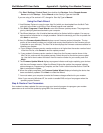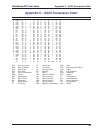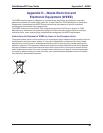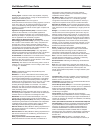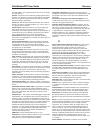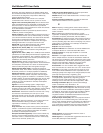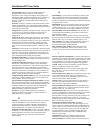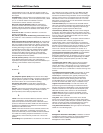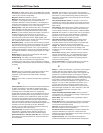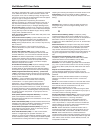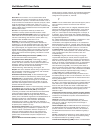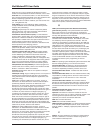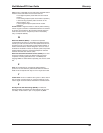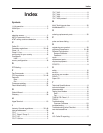
Glossary
42
MultiModemZPX User Guide
link stations) associated with a node, as requested by an SSCP
via an SSCP-PU session. An SSCP activates a session with
the physical unit in order to indirectly manage, through the PU,
resources of the node such as attached links. This term applies
to type 2.0, type 4, and type 5 nodes only.
Pipe: A logical abstraction representing the association
between an endpoint on a device and software on the host. A
pipe has several attributes; for example, a pipe may transfer
data as streams (Stream Pipe) or messages (Message Pipe).
Plug and Play (PnP): A technology for configuring I/O devices
to use non-conflicting resources in a host. Resources managed
by Plug and Play include I/O address ranges, memory address
ranges, IRQs, and DMA channels.
Point of Presence (POP): The central office’s end points of the
long distance carriers.
Point-to-Point Protocol (PPP): A protocol that lets a PC user
access TCP/IP (Internet memeber) using an ISDN terminal
adapter or a high-speed modem over a standard phone line.
Polling: Asking multiple devices, one at a time, if they have any
data to transmit.
Port: Point of access to or from a system or circuit. For
Universal Serial Bus, the point where a Universal Serial Bus
device is attached.
Primary Rate Interface (PRI): Used on ISDN. In North
America, and Japan, PRI is one 64Kbps D channel and 23 B
channels. Elsewhere, it is one D channel and 30 B channels.
Primitive: An abstract representation of interaction across the
access points indicating that information is being passed
between the service user and the service provider. The OSI
Reference Model defines four types of primitives: Request,
Indication, Response and Confirm.
Private Branch Exchange (PBX): A phone exchange located
on the customer’s premises. The PBX provides a circuit
switching facility for phone extension lines within the building,
and access to the public phone network. See also “Exchange”.
PROM (Programmable Read Only Memory - pronounced
“prom”): A permanent memory chip that can be programmed
or filled by the customer after by the manufacturer has set initial
values. Contrast with ROM.
Protocol: 1. A set of semantic and syntactic rules that
determines the behavior of functional units in achieving
communication. 2. In Open Systems Interconnection
architecture, a set of semantic and syntactic rules that
determine the behavior of entities in the same layer in
performing communication functions. 3. In SNA, the meanings
of and the sequencing rules for requests and responses used
for managing the network, transferring data, and synchronizing
the states of network components. 4. Synonymous with line
control discipline.
PSTN (Public Switched Telephone Network): A worldwide
public voice telephone network that is used as a
telecommunications medium for the transmission of voice, data
and other information.
Public Data Network (PDN): A packet-switched network that is
available to the public for individual (“subscriber”) use. Typically,
controlled by a government or a national monopoly.
Public Switched Telephone Network (PSTN): The group of
circuit-switching voice carriers, which are commonly used as
analog data communications services.
Pulse Code Modulation (PCM): 1. In data communication,
variation of a digital signal to represent information; for
example, by means of pulse amplitude modulation (PAM), pulse
duration modulation (PDM), or pulse position modulation (PPM).
2. Transmissions of analog information in digital form through
sampling and encoding the samples with a fixed number of bits.
Pulse dialing: One of two methods of dialing a telephone,
usually associated with rotary-dial phones. Compare with “tone
dialing”.
Q
Quantizing: The process of analog-to-digital conversion by
assigning a range, from the contiguous analog values, to a
discrete number.
R
Random Access Memory (RAM): A computer’s primary
workspace. All data must be stored in RAM (even for a short
while), before software can use the processor to manipulate the
data. Before a PC can do anything useful it must move
programs from disk to RAM. When you turn it off, all information
in RAM is lost.
Rate Enforcement: The concept in frame relay where frames
sent faster than the CIR are to be carried only if the bandwidth
is available, otherwise they are to be discarded. (The frame
relay network assumes that anything exceeding the CIR is of
low priority.) Rate enforcement makes sure that the network will
not get so congested that it isn’t able to meet the agreed on
CIR.
Recognized Private Operating Agency (RPOA): A
corporation, private or government-controlled, that provides
telecommunications services. RPOAs, such as AT&T,
participate as non-voting members in the CCITT.
Red Alarm: A T1 error condition generated when a local failure
(e.g., loss of synchronization) exists for 2.5 seconds, causing a
Carrier Group Alarm (CGA). See also “Blue Alarm” and “Yellow
Alarm”.
Request for Comment (RFC): A set of papers in which
Internet standards (published and proposed), along with
generally-accepted ideas, proposals, research results, etc. are
published.
RJ-11: An industry standard interface used for connecting a
telephone to a modular wall outlet; comes in 4-and 6-wire
packages.
RJ-45: An 8-wire modular connector for voice and data circuits.
Root Hub: A Universal Serial Bus hub directly attached to the
host controller. This hub is attached to the host; tier 0.
Root Port: The upstream port on a hub.
Router: A device that connects two networks using the same
networking protocol. It operates at the Network Layer (Layer 3)
of the OSI model for forwarding decisions.
Routing Information Protocol (RIP): A distance vector-based
protocol that provides a measure of distance, or hops, from a
transmitting workstation to a receiving workstation.
RS-232C: An EIA standard for a serial interface between
computers and peripheral devices (modem, mouse, etc.). It
uses a 25-pin DB-25, or a 9-pin DB-9 connector. The RS-232
standard defines the purposes, electrical characteristics and
timing of the signals for each of the 25 lines.
RS-422: The EIA standard for a balanced interface with no
accompanying physical connector. RS-422 products can use
screw terminals, DB9, various DB25, and DB37 connectors.
RS-530: The EIA standard for the mechanical/electrical
interface between DCEs and DTEs transmitting synchronous or
asynchronous serial binary data. RS-530 provides for high data
rates with the same connector used for RS-232; however, it is
incompatible with RS-232.




